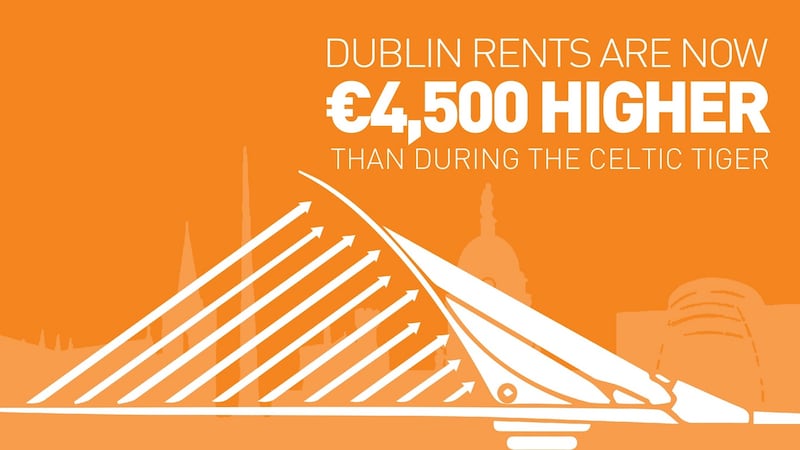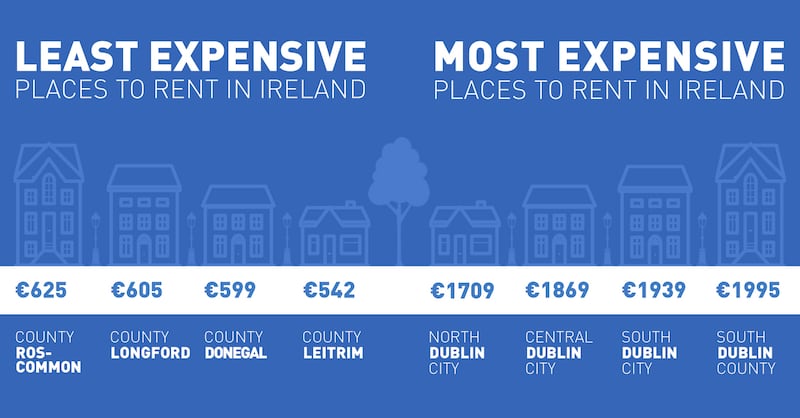Average rents in Dublin are likely to hit about €2,500 a month before the market starts to taper, a new survey shows.
According to the report, Dublin dwellers are already paying almost €400 more a month in rent than they were back in the days of the Celtic Tiger. This comes on the back of continued double-digit annual growth and despite the introduction of rent controls in 2016.
According to the Daft.ie rental report for the fourth quarter of 2017, asking prices for rented properties rose by 2.4 per cent to an average nationwide rent of €1,227. This translates into a 10.4 per cent rise on an annual basis.
This compares with an increase of 13.5 per cent in 2016, 9 per cent in 2015 and 10.7 per cent in 2014. This means that on a nationwide basis, rents are now 19 per cent higher than their 2008 peak. Rents are up by 52 per cent nationally on the lows of 2010. There are increases of slightly more than 65 per cent reported in Cork, Galway and Limerick.
In Dublin, the explosion in rents is even more noted, with rents up by 4.5 per cent in the last quarter of the year, and by 10.9 per cent on an annual basis. The latest jump means annual rents in the capital have risen by €4,500 on Celtic Tiger highs. The figures show rents have risen for 26 consecutive quarters. This shows rents have risen by 81 per cent from their lowest point in 2010, and as much as 90 per cent in the city centre.

"This is twice as long as the previous market upswing, which lasted from early-2005 to mid-2008. It's also twice as long as the downturn, which lasted the following four years," said Ronan Lyons, assistant professor of economics at Trinity College Dublin and author of the report.
Looking for “silver linings”, Mr Lyons said that the rate of inflation was slightly lower than the previous year, and that the rate of commencements of new builds was up on where it was a year or two ago.
However, he said he doesn’t expect to see the market starting to normalise for another three to four years, during which rents in the capital might continue to rise by high single- or double-digit figures on an annual basis. This would put the average monthly city rent at about €2,500, up from €1,869.
The average rent in Dublin is now as high as €1,995 in south county Dublin, or €1,520 in north county Dublin, while rents are growing at the fastest rate in the city centre (up 12.9 per cent on the year). Room rates in the capital are also on the rise – up by as much as 8.4 per cent in south Dublin – to €569.

Slumping supply
With just 3,150 properties now available to rent across the country, the ongoing dearth of supply is undoubtedly a key factor behind the upwards trend in rents. This level of supply is down by more than 20 per cent on the same date in 2016, and according to Daft.ie, is the lowest level ever recorded for this time of year. In 2010, for example, stock across the country was about 22,500, while even in 2006/2007, the number of properties available for rent touched 10,000.
In Dublin, the supply of rentals has slumped to just 1,350, down by 15 per cent on February 2017, while across Munster, just 700 rooms were available to rent, down by 20 per cent on last year.
According to Mr Lyons, while rent controls were introduced in 2016 which limit rent increases to 4 per cent, they’re not working due to the strength of the imbalance in supply and demand.
“If you’re a tenant it’s not in your interest to start quizzing the landlord if the proposed increase is only 4 per cent – even if you had the information which you don’t, as the RTB don’t publish it,” he says, adding that it was a combination of “a self-policed system, plus very little information in the market and very tight supply” that was limiting the impact of rent controls to help moderate price growth.
Priciest places to rent
South county Dublin is now the most expensive place to rent in the country, with an average rent of €1,995 just pipping the south city (€1,939), and the city centre (€1,869).
Outside of urban areas, however, rent is still muted, with the lowest rent in this quarter’s survey found in Co Leitrim (€542); Co Donegal (€599) and Co Longford (€605).
The survey also shows that it is now cheaper to buy, rather than rent, a one-bedroom apartment across Dublin, Cork, Galway, Limerick and Waterford. In Dublin 1, for example, a mortgage on a one-bed (at a rate of 3.75 per cent, with 85 per cent loan to value) will be €836 a month, compared with rent of €1,503, while in Limerick city, rent will be €746 or just €293 on a mortgage.
When it comes to a three-bedroom house, however, while it’s still cheaper to buy rather than rent in most locations, in south Dublin the typical rent (€2,065), is actually cheaper than a mortgage (€2,127).












